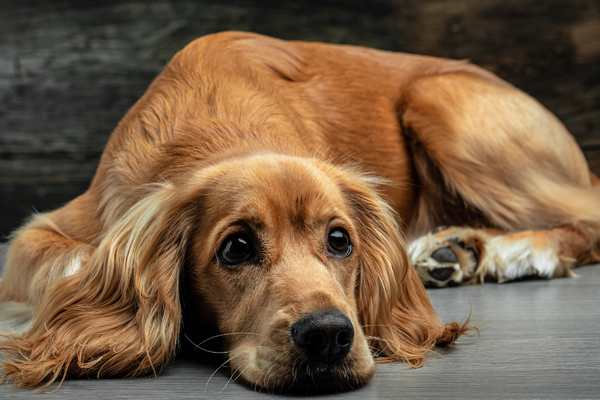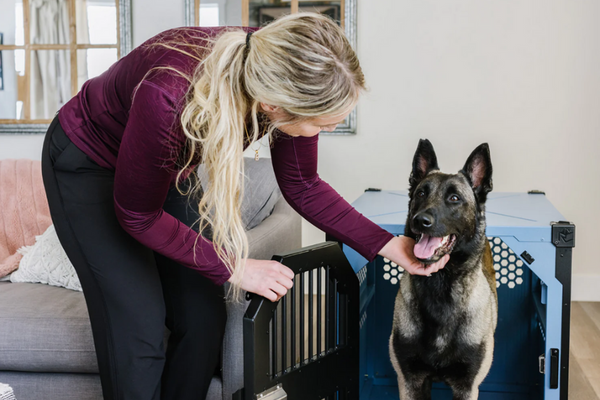It’s a big issue that baffles many pet parents. Your dog is otherwise well-behaved, but when you leave the house, it’s almost like they transform into a completely different animal. The issue of a dog destroying a house when left alone can be summed up as one simple (but actually complex) issue – separation anxiety.
Separation anxiety is a condition that occurs when dogs get hyper-attached to their owners. According to Today’s Veterinary Practice, a defining characteristic of separation anxiety is a dog showing extreme distress when spending time away from their owners. Whether pet parents are leaving the house for a few minutes to run an errand, or spending the day in the office, the result is the same.
What Causes Separation Anxiety?
According to the University of Illinois College of Veterinary Medicine, separation anxiety will most often develop within the first two years of life. However, this isn’t universally the case. Some dogs (and breeds of dogs) may be more naturally prone to separation anxiety, while others may develop the condition later in life due to various trauma. For pet parents of rescue dogs, the cause or length of time their dog has struggled with separation anxiety may be a mystery.

Pet parents of puppies can work with their dogs to lessen their chance of developing separation anxiety. When the puppy is young, leaving them alone in a crate for short periods of time can get them used to separation early. Additionally, proper socialization can help them to build the confidence they need to feel safe in a variety of different social situations, even spending time away from their owners.
A few reasons why dogs may develop separation anxiety include:
- Change of family – Being abandoned or surrendered to a shelter can be a traumatic experience for dogs. Dogs who may not have had separation anxiety before may develop the condition after spending time in a shelter or being surrendered to new owners.
- Change in residence – If you’ve recently moved house, your dog could begin to develop signs of separation anxiety. Many dogs rely on a routine for comfort and confidence, and a change in the home may leave them feeling vulnerable or confused. In these instances, an otherwise confident dog may “grow out” of the separation anxiety as they get used to their new surroundings.
- A dramatic change in schedule – A pet parent that used to work at night switching to a day shift may be the kind of dramatic change in schedule that leads to some development of separation anxiety. Like a change in residence, your dog may rely on their routine for comfort and confidence, and such a “shake-up” could lead to some anxiety development. As the dog gets used to their new schedule, they may progress out of the condition.
- Loss of a family member – The loss of a family member has a profound impact on dogs. The family member could be a dog they shared their home and “pack” with, or it could be a human they loved. Even dogs remaining in the same home, and with the same family, after the loss of a family member may develop separation anxiety.
- Not getting used to time alone while young – While it’s important to bond, train, and keep an eye on puppies, it’s also important to show puppies that time away from their owners is not something to fear. Puppies who have spent little to no time alone are more prone to developing separation anxiety as they grow older.
The Many Signs Of Separation Anxiety
Some pet parents know their dogs struggle with separation anxiety, and others may not realize that this condition is the cause of their dog’s behavioral problems. According to PetHelpful, some of the most common signs of separation anxiety include:
- Velcro-Dog behavior – Some pet parents might find it endearing when their dog follows them from room to room, but this might be an early sign of separation anxiety. This “Velcro-dog” behavior doesn’t always point toward separation anxiety, but is a symptom often cited by pet parents whose dogs struggle with separation.
- They show stress when they see pre-departure cues – If your dog paces, whines, or exhibits stressed behavior when they see you putting on your shoes, grabbing your keys, or putting a jacket on, this could be pointing toward separation anxiety. Just like how some humans may get anxious knowing they have a stressful situation coming up, dogs with separation anxiety may begin feeling their anxiety as soon as they know they’re about to be left alone.
- Dog destroying house when left alone – If your dog is otherwise not prone to destructive behaviors, but you often come home to belongings, toys, or even the structure of your home destroyed, this is one of the most common and straightforward signs that your dog may be dealing with separation anxiety.
- Your dog vocalizes when they’re away from you – Many dog owners don’t realize how noisy their dogs can be while they’re not at home. If you’re notified by your neighbors that your dog has been barking or whining for hours, or you notice barking and whining on a security camera, this could be your dog acting out in response to separation anxiety.

The Dangers Of Separation Anxiety
Before digging into just how dangerous uncontrolled separation anxiety can be, it helps to understand just how your dog is feeling at the moment. According to Whole Dog Journal, the way a dog feels when experiencing separation anxiety can be similar to how a human feels while experiencing a panic attack. Their “fight or flight” response has been triggered, and they’re trying to act out on either impulse in order to calm or soothe the anxiety they’re feeling. In doing this, they’ll often lose all sense with a sole focus on finding comfort in the moment.
A dog destroying a house when left alone is much more than just a nuisance. While you may be coming home and upset about a chewed-up shoe, a shredded couch, or even a destroyed doorframe, they could be feeling much worse. The destruction a dog will resort to while suffering from separation anxiety symptoms could cause them to injure themselves, ingest toxic materials, or ingest objects that lead to catastrophic stomach or bowel injury. Before you know it, the cost of separation anxiety is much higher than a destroyed object both monetarily and emotionally.
What You Can Do To Keep Your Dog Safe And Happy
For pet parents of dogs with separation anxiety, finding a way to keep your dog safe and happy while you’re out is a top priority. One of the best ways to do this is through crate training. According to American Humane, dogs are natural den animals, and providing them with a den space helps them to feel instinctual comfort, security, and safety. With a slow and positive introduction to the crate, they now have a space that helps them to relieve these anxious feelings without risk of destruction or injury.
Dogs of any age can be successfully crate trained. The process does take patience, but it’s an investment that benefits you and your dog for a lifetime. The first step is finding the right crate, and there are a few features that should be at the top of your priority list. For dogs with separation anxiety and destructive tendencies, a chew proof and tough crate is crucial. To make the crate doubly chew proof, chew guards for the door of the crate may be a welcome addition.
Once you’ve found the right crate, your next step is choosing the perfect size. According to PetMD, your dog should be able to stand, turn, and lay down comfortably inside of their crate. While sitting down in the crate, the top of the crate should be about 2 inches from the top of their head. If you’re measuring your dog to find the right crate size online, a good rule of thumb to follow would be to select a crate size 2 to 3 inches higher than their head while standing, and 3 to 4 inches longer than the measurement between their nose and the tip of their tail.

After you have your crate at home, you’ll want to acclimatize your dog to their new crate slowly. With a new object in the home, they may be curious but cautious at first. Place the crate in a quiet area of your home and give your dog a few days just to get used to the way it looks, smells, and its presence in your dog’s home.
Once your dog is a bit more comfortable with the presence of the crate, you can encourage them to go inside of it using toys, food, or favorite treats. Leave the door open, leave a snack or a special toy inside of the crate, and encourage your dog to go inside to enjoy their desired item. When the dog enters the crate, follow the action with plenty of praise and reward.
After a while of going into the crate with the door open, you may be ready to try spending a few seconds in the crate with the door closed. Start with about 30 seconds at first, giving your dog a special item in their crate, closing the door, and turning your back. When your dog is able to do this successfully and without upset, up the time to a minute or so. Gradually increasing this time gets them more comfortable with time spent in their closed crate. After a while, try leaving the room during their closed crate time.
With patience and perseverance, you can build a solid positive association with the crate and your dog, teaching them that their crate is a happy, safe, and comfortable place to relax. For dogs with separation anxiety, it will become a refuge they can rely on to ease their feelings of fear and stress while you’re outside of the home and save them from any destructive tendencies they may have.

